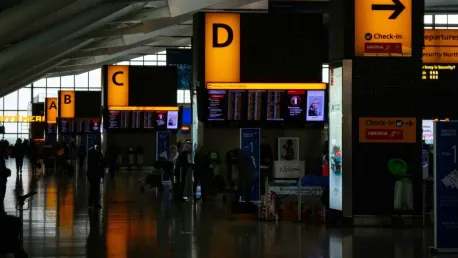Recent disruptions at Heathrow Airport have highlighted the vulnerability of critical infrastructure in the face of unexpected incidents. A fire at an electricity substation in Hayes led to significant flight cancellations and delays, drawing attention to the resilience of the airport’s power systems. Despite the shutdown, National Grid CEO John Pettigrew assured that there was ample power available from the remaining substations to meet Heathrow’s operational needs, emphasizing the robustness of the system.
The Substation Fire and Its Immediate Impact
On Thursday, a fire broke out at the North Hyde electrical substation, necessitating an immediate suspension of flights until the following evening. The incident, which involved the unusual failure of a transformer, was described by Pettigrew as unprecedented in his 30-year career. Heathrow’s secondary substations were able to provide adequate power; however, the complexity and size of the airport required a careful and safe power down of critical systems before these could be rebooted. Mr. Pettigrew’s confirmation of power availability underscored the system’s resilience, yet highlighted the inherent challenges of recovery in such a large-scale facility.
The fire led to considerable operational disruption, compelling Heathrow Airport to implement extensive safety protocols. The process of safely shutting down and rebooting essential systems was intricate and time-consuming, contributing to the delayed resumption of services. Heathrow CEO Thomas Woldbye noted that a backup transformer failure compounded these difficulties, as standard safety procedures necessitated shutting down systems in order to realign and stabilize power distribution from remaining substations.
Historical Vulnerabilities and Current Resilience Measures
In a 2014 report by consultancy firm Jacobs, main transmission line connections to Heathrow were identified as potential weaknesses, capable of disrupting vital airport functions. The report acknowledged that while there are vulnerabilities in transmission lines, the airport’s on-site generation and resilience measures were deemed sufficient to manage such interruptions effectively. This report’s findings are essential in understanding the level of preparedness and adaptability within Heathrow’s power infrastructure.
The capability of secondary substations to support Heathrow after losing a major substation reflects robust contingency planning. However, the requirement for safely shutting down and rebooting systems suggests that while there’s resilience, the process is still complex and challenging. This incident thus serves as a crucial learning point for evaluating and potentially enhancing contingency measures further to ensure faster recovery in future emergencies.
Official Investigations and Response Efforts
Energy Secretary Ed Miliband has called for an urgent investigation into the power outage, engaging the National Energy System Operator and Ofgem under the Energy Act. Initially led by counter-terrorism officers, the probe has now been taken over by the London Fire Brigade, which is focusing on the technical inspection of the electrical distribution equipment involved. The urgency of these investigations highlights the critical need to understand and resolve the root causes of such a disruption to prevent recurrence.
Simultaneously, an internal review of Heathrow’s crisis management and response is set to be conducted by former transport secretary Ruth Kelly. This review aims to scrutinize the airport’s handling of the incident, examining emergency response protocols and coordination with emergency services. The results from this review will likely influence future strategies for improving crisis management and expediting operational recovery during unexpected outages.
Efforts to Restore Normalcy and Implications
Throughout the disruption, Heathrow officials, staff, and emergency services worked diligently to ensure the safe reopening of the airport. British Airways made significant efforts to resume a near-full flight schedule, and by Saturday, the airport had returned to operational status. These coordinated efforts highlight the importance of teamwork and robust crisis management protocols in overcoming challenges posed by such unforeseen events.
As Europe’s largest airport, Heathrow handles over 83.9 million passengers annually, making the implications of any disruption far-reaching. The power outage affected approximately 200,000 passengers, demonstrating the significant impact that infrastructure failures can have. This event underscores the necessity for continuous evaluation and enhancement of resilience strategies to prevent operational interruptions and ensure passenger security and satisfaction.
Strategic Takeaways and Future Considerations
Recent disruptions at Heathrow Airport have underscored how susceptible essential infrastructure can be to unforeseen events. A fire at an electricity substation in Hayes significantly impacted flight schedules, causing numerous cancellations and delays, and bringing to light the importance of the airport’s power infrastructure resilience. In the aftermath, National Grid CEO John Pettigrew reassured that despite the fire-induced shutdown, the remaining substations had sufficient power to support Heathrow’s operations. Pettigrew emphasized that the power system’s robustness played a key role in preventing further operational chaos. This incident underlines the necessity for critical infrastructure to have strong contingency plans and resilient systems in place. Airports such as Heathrow serve as vital hubs for international travel, and any disruption can have widespread implications. This recent event serves as a reminder that while existing systems may be robust, proactive measures and ongoing assessments are essential to maintain operational continuity in the face of unexpected challenges.









